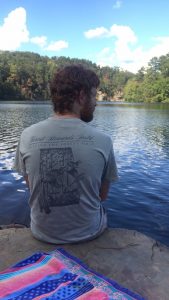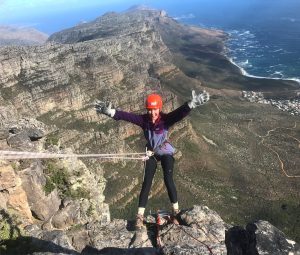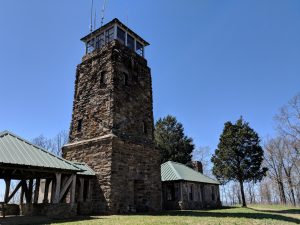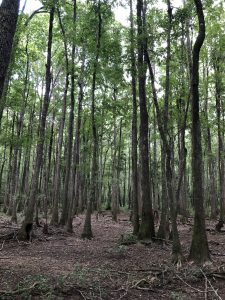The University of Alabama Environmental Science Program is among the oldest environmental science degree-granting programs in the nation, and has a long tradition of helping students develop the skills and gain the experiences needed to launch their careers or continue on to advanced study. Our students work in a wide range of environmental positions across the US and abroad. You can learn more about careers in environmental science at the U.S. Bureau of Labor Statistics.
Undergrad to Grad Spotlight
Raien Emery

The following story was written by current graduate student Raien Emery, who completed a B.S. in environmental science through UA’s program.
Now a graduate student in Dr. Hart’s Forest Dynamics Lab, I was an Ernest F. Hollings Scholar 2018-2020. This is an undergraduate scholarship program funded by the National Oceanic and Atmospheric Administration (NOAA) that provides funding for juniors and seniors and includes a ten-week paid internship at one of the NOAA sites the summer between. The Hollings program was an incredible experience for me, as I spent the summer of 2019 fishing for juvenile Chinook salmon along the Washington coast and analyzing salmon otoliths in Seattle. At the end of the internship, the program hosts a symposium for all Hollings scholars at NOAA headquarters in Silver Spring, MD, where we present our summer research. Topics range anywhere from weather and climate, to fisheries, to anthropogenic impacts on the earth. Additionally, the Hollings program provides funding to attend up to two conferences to present your research. Through this program, I was able to delve into a completely different field of research, obtain experience working in a federal research facility, and network with peers and mentors from all across the United States.
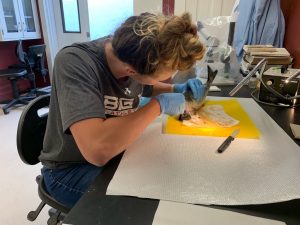
Beyond that, I also enjoyed my time in the Pacific Northwest, from the ocean to the mountains. The monetary value of this program, including multiple all-expenses paid trips, is likely around $40,000, though the research experience, networking opportunities, and fun you’ll have along the way make it worth much more. If you are interested in pursuing research related to the ocean or atmosphere, I could not recommend this program more! You must apply as a sophomore (or with two-years of your undergraduate degree remaining) by end of January 2021. Follow the link here for more information and do not hesitate to reach out to me with any questions.
https://www.noaa.gov/office-education/hollings-scholarship
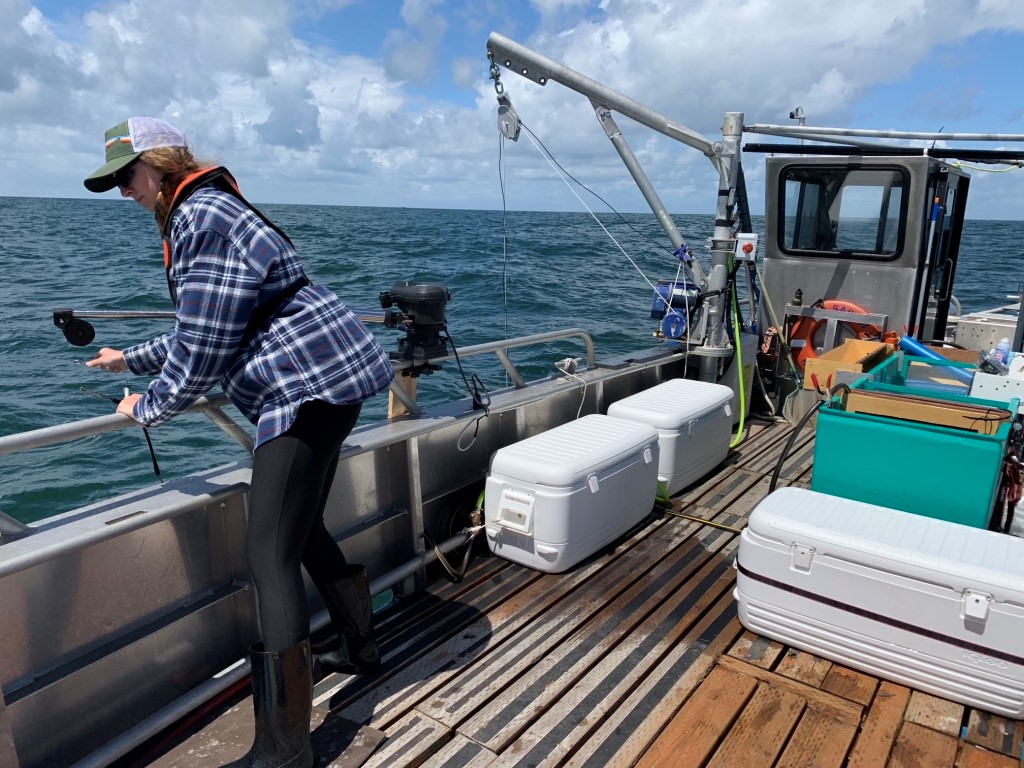
Forest Stewards Guild
The following piece was written by graduate student Alexandra Logan.
The Forest Stewards Guild (FSG) is a nationally recognized professional organization with the mission of “putting the forest first”. The FSG: Student Chapter at UA seeks to implement this mission statement through community outreach, scientific learning, and outdoor recreation.
In the past, FSG: Student Chapter members have volunteered to help build trails and plant trees in nearby natural resource areas. More recently, the chapter has developed a working relationship with Project Learning Tree (PLT), a Sustainable Forestry Initiative program, which uses trees and forests to teach environmental conservation to grade school students. The FSG: Student Chapter hosts at least one PLT workshop a semester to train members on the incorporation of environmental education with fun classroom and outdoor activities. Once trained, club members are able to visit local elementary schools to teach lessons on environmental issues. PLT instructors and sponsors are found in all 50 states and in multiple countries. Becoming a certified environmental educator through the FSG: Student Chapter not only allows members to connect with local schools and students, but it also provides an introduction to a far-reaching non-profit organization.
Continued environmental education is also a priority for FSG: Student Chapter members. Tree ID hikes are typically coordinated every semester to learn more about local vegetation. Discussions concerning environmental conservation principles and issues will also usually accompany these outings. The UA Arboretum and Lake Nicol have both been used as sites for club hiking trips. Lake Nicol is located only about 20 minutes from downtown Tuscaloosa, and with its miles of trails and beautiful water it is a perfect day trip for anyone needing a quick escape from T-Town.
In addition to learning about the environment, the FSG: Student Chapter prioritizes the escape to the outdoors. Every semester at least one outdoor recreation trip is planned. As mentioned previously, Lake Nicol is a popular place to visit for hiking and swimming. Cahaba River Tubing is located about 45 minutes from Tuscaloosa, and offers a chance to have a lazy day floating down the river. Members of the chapter are constantly looking for new outdoor opportunities that will provide students a break from university stress and a time to relax in nature.
The Forest Stewards Guild: Student Chapter is a fantastic organization for anyone who is interested in spending time outside and giving back to the community through environmental education. Students who would like to learn more or join the chapter can feel free to reach out to the current president, Raien Emery, through email at rkemery@crimson.ua.edu.
Accelerated Master’s Program
The following piece was written by ES alumnus and current graduate student David Phillips.
The Accelerated Master’s Program (AMP) allows undergraduate students at The University of Alabama to take graduate level courses that count towards both their bachelor’s and master’s degree. Exceptional undergraduates nearing the completion of their bachelor’s degree can follow the same graduate school application that a regular master’s student would fill out. The admissions process is the same, so available positions are highly competitive. You can shave at least one semester off the standard four required for a master’s degree. In some cases, AMP students finish both of their degrees at the same time. This is especially useful if you have financial aid of some sort that lasts for a set number of years or semesters.
I applied to AMP in the summer of 2019. My advisor, Justin Hart, helped me determine that graduate school was the right choice for me. Once we knew that, I applied to AMP so that my last semester of undergrad could count towards my master’s degree. Meeting with your advisor is critical for AMP. Not only do you have to discuss if it is the right option for you, but you also have to determine what graduate level courses you need to take during your AMP semester(s). There are required courses for graduate students, and you need to have a roadmap for your future semesters.
I took two graduate courses as an AMP student: GY 510 (geography of national parks) and GY 589 (forest ecology and vegetation analysis). Depending on the semester you enter AMP, you could potentially take GY 500 (research methods and traditions) or GY 523 (quantitative methods) to get a head start on the required graduate student courses. Upper level courses that have a 500-level option usually differentiate between graduate and undergraduate students by adding additional assignments for the graduate students. In my experience, these assignments consist of extra labs or a final project.
A large portion of my semester as an AMP student was spent ironing out my thesis idea with my advisor, which is what any first semester graduate student would likely be doing. Graduate students still have courses with set deadlines, just like undergrads, but the thesis is another beast. You might have a general timeline for your thesis, but there are not usually any dates set in stone. Depending on the type of graduate student you are, this could be a good or bad thing. There is more self-discipline involved as a graduate student, and it can be easy to fall behind on your thesis if you do not make an active effort to work on it. This is one reason why it is important as an AMP student to make connections with your graduate peers. My fellow graduate students in the Forest Dynamics Lab helped me through my semester as an AMP student, and I am sure they will continue to help me over the next year and a half.
LEAD Abroad
The following piece was written by Environmental Science undergraduate Katelyn Morris.
Would you believe that you could spend your summer skydiving, bungee jumping, swimming with sharks, and walking with elephants all while developing your leadership abilities and gaining a more comprehensive world view? I never imagined I would spend a summer that way until I discovered the incredible study-abroad program called Lead Abroad. This program Lead Abroad, based out of Oglethorpe University in Atlanta, Georgia, created a unique and immersive five-week-long experience that included all of those activities and more in Cape Town, South Africa!
The program, called LEAD Cape Town is comprised of two courses, service, and adventure. The two courses are called Leadership: Global Theory and Practice and Global Citizenship and Civic Engagement. These courses, a total of six credits, fulfilled six of my upper-level elective credit requirements at UA. The interdisciplinary curriculum involved lessons about leadership and community involvement centered around developing each person as an individual. During these courses, we were given the tools and encouragement to get to know ourselves more deeply and consider our personal values and vision for our life.
It was an especially unique time in Cape Town when I was living there during the summer of 2017 because the city was experiencing a dire water crisis resulting from a combination of abnormal draught and poor resource management, and all inhabitants could tangibly experience the true application of civic engagement and global leadership. The city was rapidly approaching ‘Day Zero’—the day when the city’s water supply would be completely depleted. All residents and visitors were asked to keep showers to a maximum of five minutes and buy and use bottled water whenever possible. Thankfully, Day Zero was successfully averted and the city’s water supply has since been replenished to more secure levels, but for me, as well as many others, the impact of this crisis was profound and irreversible. Personally experiencing the dire and potentially catastrophic culmination of adverse environmental conditions mixed with inefficient natural resource management opened my eyes, for the first time, to the immeasurable importance of living sustainably and interacting responsibly with the environment and natural resources. This experience influenced me so deeply that, upon returning from South Africa, I changed my major from biology to environmental science so that I could more closely study the Earth systems as well as work to understand the optimal role of human begins in coexisting with our environment.
In addition to the coursework, we spent one week volunteering in a local community, developing an after school program for the community’s children and spending time with the local families. It was incredibly rewarding to experience another culture in such an intimate setting. We also spent one week traveling on the beautiful Garden Route along the southern coast of the country—eating incredible food, bonding with friends from all over the world, experiencing insane adventures, and conquering some of our greatest fears. Studying abroad pushed me out of my comfort zone in countless ways and allowed me to transform into the person I am today. It was an invaluable experience that I will cherish forever!
Undergraduate Research Experiences
Forest Dynamics Lab
The following piece was written by UA alumnus Jon Kreussuk.
Coming to the University of Alabama I did not have a clear path on what I wanted to study, just that I enjoyed the outdoors and a full-time desk job would not work for me. My limited experience with Environmental Science came from a high school elective but that combined with my interest with science was enough of an influence to pursue an ES degree. While the courses were interesting, a piece of the puzzle felt missing during my first semester. My introduction to undergrad research in Environmental Science was when I attended a Club Geography tailgate that same semester. One of the graduate students at the time told me to take Dr. Hart’s Geography 101 section the following spring. It quickly became apparent he was someone I wanted work with so I asked if his Forest Dynamics lab needed volunteers. He said they could use the help and fall of 2016, I started as a volunteer technician.
As a technician, I was assigned to tasks in sample preparation and measurement so that the graduate students could focus on the analysis and research. My first task was tree cores which needed to be mounted, sanded, dated, and measured and was an introduction to the procedure of following methods in research. I also got the opportunity to go out and do field work with the lab, which consisted of establishing plots and taking measurements within them. The fieldwork and lab trips I participated in also took me to some beautiful natural places both within and outside of the state. The tasks I performed as a technician, and later research assistant, were applications of techniques and methods we covered in classes such as Forest Measurements or Forest Ecology so that allowed me to both be more prepared for those courses and also have the skills necessary for a position in forestry.
In addition, I had opportunities to go to conferences and network with professionals within the forestry profession. Being able to make these connections is critical in any field as they may offer up opportunities that would be otherwise unobtainable and provide future collaborations. I continued as a tech for three more semesters until I took up leading a project focusing on longleaf pine at a site called Flagg Mountain in Coosa County, Alabama. The study allowed me to develop leadership skills, as I was the one who had to guide all my volunteers on proper methods for data collection, processing, and analysis. The entire time I had guidance from Dr. Hart and the graduate students in the lab but in the end, it was my responsibility to execute the study and prepare the paper on its findings.
I chose to go the route of pursuing masters after my undergraduate degree so the experience as a principal investigator and having a publication allowed me to market myself as a much more experienced candidate for potential programs. Ultimately, I credit my experience from undergraduate research in the Forest Dynamics Lab to me getting the masters position at the University of Arkansas Monticello and establishing my passion for the field of forestry.
USDA Forest Service
The following piece was written by UA alumnus Daniel Risman.
Working for the USDA Forest Service, in coordination with The University of Alabama’s Forest Dynamics Lab, was an incredible experience that I will never forget. As a Forestry Technician, I was granted the opportunity to assist Forest Service personnel in administering the Terrestrial Ecological Unit Inventory (TEUI) classification system throughout the Oakmulgee Ranger District of the Talladega National Forest. The TEUI ecological classification system is currently being implemented throughout regions of the entire United States, and I was grateful to play a role in the development of this project.
The workday often involved hiking through Alabama’s Fall Line Hills for up to 10 hours a day. Field work ranged from environmental sampling to accumulating soil and vegetation data. Generally, my crew and I took turns in completing our tasks, whether that was digging holes, assessing types of plants, or taking tree measurements. Our work took us from the top of exposed, xeric ridgetops to low-lying mesic drainages, all of which contained distinct species of plants and animals.
I was absolutely amazed by how much biodiversity I witnessed throughout my few months in the Oakmulgee Ranger District. Almost every day in the field, I observed unique species of flowers, trees, herbs, weeds, fungi, snakes, birds, insects, and so much more. My favorite experiences by far was being witness to the vast stretches of longleaf and loblolly pine stands, as well as observing the immensity of mixed forest communities native to the region. These areas were something I was never able to experience at home in Illinois, and have given me great insight into how diverse wildlife is throughout the nation. Along with that, it felt amazing to take a breath of fresh air every morning, and truly encounter what nature had to offer.
Not only did this opportunity provide significant experience in preparing me for a future career in the environmental sciences, it also further invigorated my passion for environmentalism and forestry. With the current state of environmental issues facing our nation, I know it is more important now than ever to protect areas such as Oakmulgee, especially as they provide so many recreational, economic, and educational opportunities.
My suggestion to future environmental science students and environmentalists would be to take part in an opportunity such as this, as it is a genuine experience that so few get to participate in and enjoy. If I could do it again,I would in a heartbeat, as The University of Alabama, UA Forest Dynamics Lab, and USDA Forest Service have so much to offer.
Our alumni are employed by a range of organizations, such as:
- The US Bureau of Land Management
- The US Geological Survey
- The US Forest Service
- The US National Oceanic and Atmospheric Administration
- The US National Park Service
- The Alabama Geological Survey
- Private consulting firms
- Land trusts
- Electric utility holding companies
University of Alabama Environmental Science graduates currently serve as:
- Land managers and planners
- Conservation program managers
- Arborists
- Ecologists
- Hydrologists
- Environmental analysts
- Park rangers
- Foresters
- Outdoor educators
